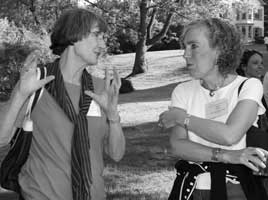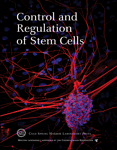|
LXXIII: Control and Regulation of Stem Cells 2008 |
|
|

|
Brigid Hogan & Elaine Fuchs SYMPOSIUM SYNOPSIS LIST OF PARTICIPANTS CONTENTS OF SYMPOSIUM VOLUME PHOTOGRAPHS PUBLISHED VOLUME PRESENTER INTERVIEWS  |
Control and Regulation of Stem Cells
May 28 - June 2, 2008
Symposium Synopsis
Meeting Organized by Bruce Stillman, David Stewart, and Terri Grodzicker
The roots of stem cell research can be traced back to classical work in embryology and regeneration performed in the 19th century. By the early 1900s, researchers in Europe had come to understand that various types of blood cells were derived from a particular "stem cell," resulting in physicians' attempts to administer bone marrow by mouth to patients suffering from anemia and leukemia. Although such therapy was unsuccessful, laboratory experiments eventually demonstrated that mice with defective marrow could be restored to health with infusions into the bloodstream of marrow taken from other mice, stimulating physicians to speculate whether it was feasible to transplant bone marrow from one human to another. By the late 1960s, pioneering work by Till andMcCulloch demonstrated the existence of hematopoietic stemcells. Later, bonemarrow transplantation (a stem cell transplant) was dogged by problems of histocompatability, but as the basis of the HLA system became increasingly understood, successful bone marrow transplantation between unrelated individuals was first demonstrated in 1973.
Stem cell research has since exploded, with the derivation of mouse embryonic stem cells in 1981, the culturing of neural stem cells as neurospheres in 1992, and the establishment of the first human embryonic stem cell lines in 1998. A definitive link between stem cells and cancer was established when certain leukemias were shown to originate from hematopoietic stem cells. During the last decade, the concept of adult stem cell plasticity has gained credence, although many findings have proved controversial, and the ethical arguments for and against the use of human embryonic stem cells have been widely debated on national and international levels. Within the last 2 years, it has been reproducibly established that an embryonic stem cell–like state, previously achieved only by somatic cell nuclear transfer into enucleated oocytes ("cloning") or by fusion with embryonic stem cells, can be induced by reprogramming differentiated adult cells using a simple combination of key transcription factors.
Progress in stem cell research is now extremely intense, with more than 5000 research papers on embryonic and adult stem cells published in reputable scientific journals every year. It therefore seemed appropriate to focus the 73rd Symposium on this important and rapidly developing field, providing a unique synthesis of the exciting progress being made in the field of stem cell biology, not only for the Symposia attendees, but for a wider global audience via interviews freely available on the world wide web, and, we anticipate, for readers of these Proceedings.
In organizing this Symposium, we relied on the assistance of Elaine Fuchs, Rusty Gage, Greg Hannon, Ron McKay, Davor Solter, and Allan Spradling for suggestions for speakers. Opening night speakers included Rudolph Jaenisch, Minx Fuller, Arturo Alvarez-Buylla, and Max Wicha, and Irving Weissman presented the Reginald Harris Lecture on normal and neoplastic stem cells. Elaine Fuchs enlightened a mixed audience of scientists, lay friends, and neighbors with her Dorcas Cummings Lecture on skin stem cells, and Brigid Hogan ended the meeting with a masterful and eloquent Summary.
This Symposium was attended by 465 scientists from more than 30 countries, and the program included 68 oral presentations and 177 poster presentations. We particularly thank the Lisbon-based Champalimaud Foundation for their extensive and generous support of this year's Symposium. Additional funds to run this meeting were obtained from the National Institutes of Health. Financial support of our meetings program from corporate patrons, benefactors, sponsors, associates, affiliates, contributors, and foundations is essential for these Symposia to remain a success and we are most grateful for their continued support.
We wish to thank Val Pakaluk and Mary Smith in the Meetings and Courses Program office for their efficient help in organizing the Symposium. Joan Ebert and Rena Steuer in the Cold Spring Harbor Laboratory Press, headed by John Inglis, ensured that this volume would be produced. We thank them for their dedication to producing high-quality publications.
Bruce Stillman
David Stewart
Terri Grodzicker
March 2009
Search images: